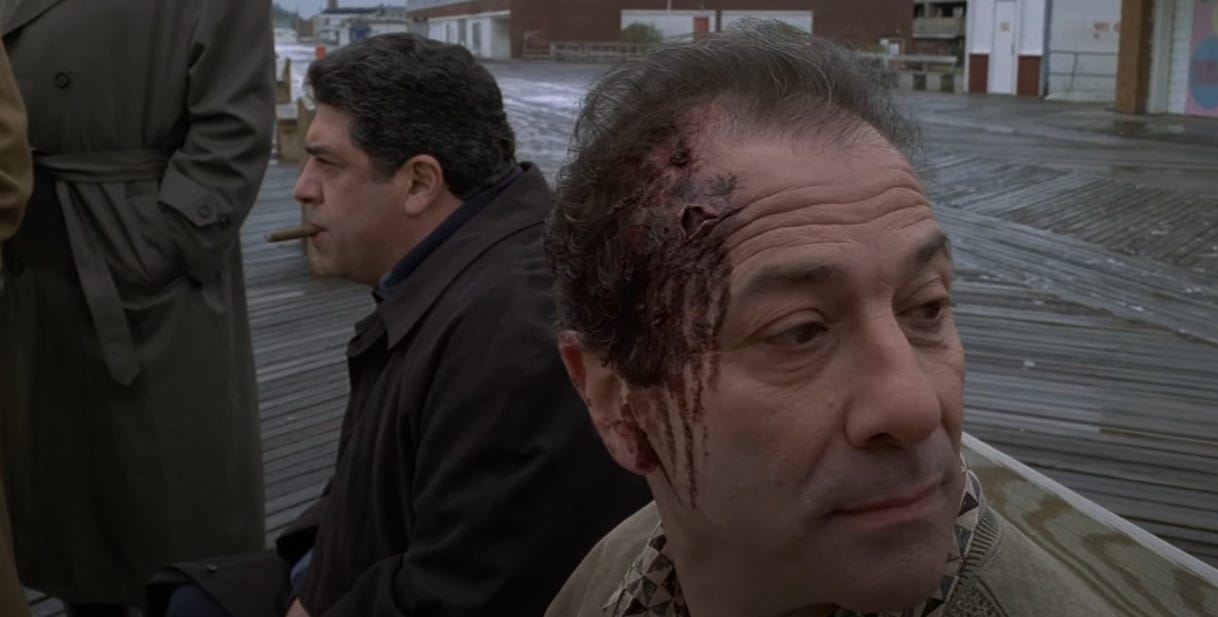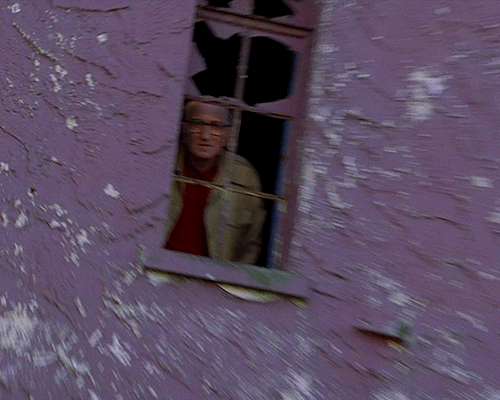Fever Dreams, Funhouses, and Premonitions of Death
Horror Moments, The Sopranos Edition
‘Horror Moments’ is a weekly series examining horror-inflected scenes and themes in unexpected places. The ‘moments’ are published weekly on Thursdays in short series, and I share articles on the history of magic, theatre, storytelling, and more on Mondays. Catch up with the recent horror opera series here and the full back catalogue of horror moments (from Wallace & Gromit to Shakespeare) here. Don’t forget to subscribe!
This week, we use a fever dream sequence from The Sopranos to explore how storytellers can combine physical sickness with psychological guilt to make a frightening dreamscape. Don’t worry if you haven’t seen The Sopranos, everything will still make sense!
Contents
The Start of the Nightmare
Tony Soprano is making his way along an empty boardwalk. A cold wind is whistling in his ears and snow lies on the muted scenery like dust.
He approaches a group of men clustered around one of the benches that faces out to the sea. “Can you believe this shit? Fucking June, my daughter’s graduating in a week.”
“Spring snow.” one of them replies. “Happened when my parents got married. Won’t last.”
Only one person fails to react to the newcomer, or to this conversation. Tony looks at this odd-one-out more closely. His face is in profile and completely still, frozen and impassive. A cigar is in his mouth, his eyes don’t leave the distant waves.
It’s a man Tony knows extremely well, his one-time trusted friend and colleague — a man whose murdered body he will soon be throwing to the sea.
Ghosts on the Boardwalk
Season 2 episode 13 of The Sopranos is called ‘Funhouse’ and features a string of dreams that mob boss Tony Soprano is having as he recovers from food poisoning. The first of these dreams, the boardwalk scene described above, is one of the earliest truly horror-inflected moments in the show and sets the stage for later episodes like the menacing ‘Test Dream’ which we explored last week. In ‘Funhouse’ we get six much shorter dreams, snapshots of Tony’s inner turmoil as he slips in and out of sleep.
Tony has got sick at the worst possible time because he is facing a huge personal crisis. The dreams reveal his growing realisation that his old friend Salvatore “Big Pussy” Bonpensiero had flipped and started wearing a wire for the government. Tony will have to execute him for the gross betrayal. What better way to dredge up Tony’s buried sorrow, guilt and anger than to hand him over for an episode to a fever that will force his suppressed thoughts to take on vivid form in disturbing surreal interludes?
From a storyteller’s point of view, this choice was also a stylish way to sidestep tedious exposition. As creator David Chase explained:
“‘Funhouse.’ That came about because I couldn’t bear the fact that we were going to have to do some kind of procedural in which Tony found out Pussy was a rat. Like he was going to have to call up some cop, or some guy would come to him and then he’d follow up on the lead. And they’d stake out Pussy’s house. And they’d follow him to the FBI. Blah, blah. I fucking would have wanted to kill somebody. So I thought, “How can he just know it?” Can’t we skip all that crap?”
So here, for the first time, nightmare-logic reigns.
The whole boardwalk mini-dream revolves around a terminal diagnosis, Tony has apparently been given months to live and imagines that his friends are commending him for planning to set himself on fire and die quickly instead of lingering on in a hospital. There’s even a dead man present alongside the living characters, Philly Parisi, who reveals a huge gunshot wound as he turns his head. “I’m sorry I had to do that,” Tony tells him. Philly nods.
Yet for all this, the subtext of the dream is clear. It isn’t Philly or Tony who has been marked for death today, but Pussy, that silent figure in amongst the rest. The dream ends with Tony, doused in petrol, realising that Pussy has vanished away. “What if these doctors are wrong?” says his nephew Christopher as Tony flicks the lighter. Then in a blaze, the dream ends.
You can see all the ingredients of what is really plaguing Tony: Pussy isn’t part of the group anymore, he’s turned his face away from Tony, someone has been whacked by Tony but understands that it was just something ‘he had to do,’ Pussy is suddenly absent and Tony fears that somehow they have got it wrong…
Frightening Funhouses
More dreams follow. Tony is back on the boardwalk where he encounters various strange images, like the extremely creepy ‘Tillie’ mural, a real landmark on the Palace Amusements in Ashbury Park Jersey where the sequence was filmed. It’s one of those relics of entertainment that have lost whatever whimsical charm they once had and are now just terrifying (like clowns *shudder*.)
We cut immediately from the shot above to a sudden view of Tony’s elderly Uncle Junior who is glimpsed briefly through a broken window before he shrinks away, a real face staring down at him along with the painted Tillie. (We’ll come back to the concept of a jump scare next week). Lots of viewers found this the most frightening moment:
Finally, Tony dreams of hearing Pussy’s voice emanating from a fish on a counter top. It’s a strangely comical exchange at first as Pussy explains his price and weight.
“You’ve lost a lot of weight,” says Tony.
“Swimming. Best exercise. Works every muscle group.”
“Get the fuck out of here, you never exercised once in your life.”
“Anyway. Four dollars a pound.”
There is a pause. The sea laps the beach. Then the fish tells him.
“You know I’ve been working with the government, right Ton?”
What follows isn’t a real confession, of course. In Tony’s feverish imagination he is at last facing up to the realisation that his friend really has betrayed him. He knows why too, as the fish reminds him: “you passed me over for promotion, Ton. You knew.” When Pussy makes a joke about ‘sleeping fishes’ Tony is furious that he’s making light of the situation. The true horror of this episode, the climax of these nightmares, is not a person’s fear of their own impending death, but the fear of having to murder a person once trusted and loved.
The title of the episode, ‘Funhouse,’ plays on the idea that Tony’s mind has become a carnival of uncanny images, a hall of distorting mirrors. It’s a setting you often get in horror films. Carnival of Souls (1962) makes an abandoned fairground on a pier the site of its heroine’s psychological unravelling.
Jordan Peele’s Us (2019) introduces the central menace of a frightening doppelganger through a sequence where a lost child sees something awful in a hall of mirrors.
Yet for all that these films reach for and achieve a sense of horror, I don’t think I’ve ever seen a funhouse sequence that I found as profoundly unsettling as this episode of The Sopranos. Combining that setting with the feverish inflammation of the protagonist’s mind was a stroke of genius, and the decision to tell the story of Pussy’s downfall through his murderer’s grim journey from denial to resolve creates a nightmare like no other.
Pale Horse, Pale Rider
As a post script to the above, one of the best depictions of fever dreams in literature comes from the extremely underrated Pale Horse, Pale Rider (1939) by Katherine Anne Porter. It’s a novella set during the Spanish Flu that devastated America and Europe after the First World War and takes its name from the description of Death in the book of Revelation. Like Tony, its narrator, Miranda, encounters death in many forms as she slips in and out of consciousness. The opening scene sets up a similar environment of uncanny familiarity, not quite an abandoned boardwalk by a funhouse, but similarly chilly and laced with dread:
Just as Tony slowly comes to accept that he is the bringer of death for his old friend Pussy, Miranda realises that she herself is a pale rider of sorts: it is because of her that her lover will die since he has contracted the disease by nursing her. Porter’s masterful descriptions of the apprehensions that plague Miranda as the disease takes hold would surely feel familiar to Tony:
The ‘Funhouse’ episode of The Sopranos changed the show forever, introducing febrile horrors into an otherwise grounded crime drama. It was because of its success that longer dream sequences like the ‘Test Dream’ happened at all, and was exactly the kind of innovative storytelling that made The Sopranos a benchmark of prestige television.
Next week…BOO! But until then, happy nightmares everyone.
AND BEFORE YOU GO…
A Special Thank You
A massive thank you to my latest paid subscriber
whose Substack you should all go and check out. Kev writes both short form and longer form comic strips along with occasional essays and I’m extremely excited about the upcoming ‘Hiding Under the Leaves’ folk horror anthology which Kev has overseen with The Slab Press. Thank you so much for helping me spend time in the funhouse of my mind writing articles like this!Horror moments are posted every Thursday and a wide variety of articles exploring the history of magic, theatre, storytelling, and more are published on Mondays.
Remember that you can pay to subscribe for extra benefits or buy me a coffee here to keep me writing. You can also like, share, comment, and recommend to help the substack grow. Thank you!















Am I going to have to try The Sopranos again? I only saw a few episodes but it didn't hook me. Now I'm more interested than ever! Could have been the relentless, badly timed adverts on Now TV...
Oh, yes, those sequences are so well done and so uncanny. That bit where he's walking but not making progress and that guy slides past him on a dream-travelator...!
I liked how they referred back to the talking fish in a later episode when someone buys Tony one a singing-fish-on-a-plaque. Everyone's laughing and Tony looks *very* uncomfortable. It's horrible being reminded of something you've seen in a nightmare, and especially so when it's tied to guilt and horror for Tony.